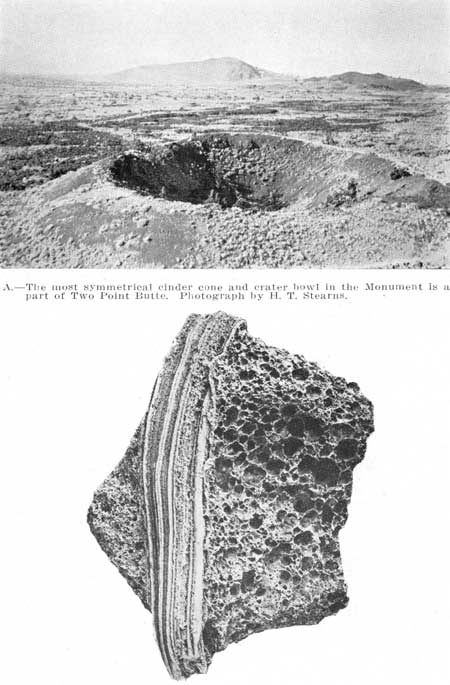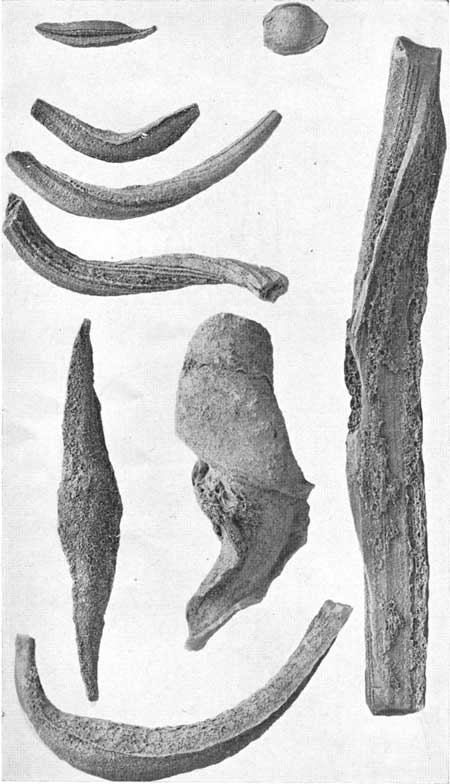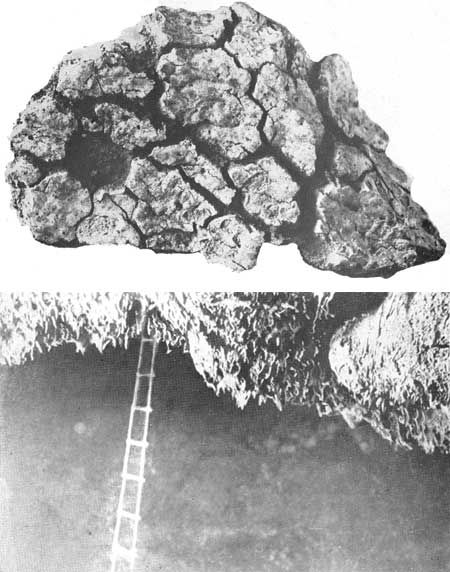
|
Idaho Bureau of Mines and Geology Bulletin
Craters of the Moon National Monument, Idaho |
AGE OF THE FLOWS.
Everyone who visits the Craters of the Moon is impressed with the freshness and barrenness of the black lava flows. However, the longer the visitor remains and wanders over the lava fields the more he is impressed with the time that must have elapsed since the last eruption. The absence of soil on many of the flows is easily accounted for. All the fine dust that falls on the lava surface or results from the weathering of the crusts is blown off or sifts into adjacent cracks. This hidden soil accounts for the presence of the numerous shrubs and pines that have taken root in crevices where no soil is visible. In Hawaii many of the historic lava flows are covered with vegetation, but in the desert are on the southwest slope of Kilauea both historic and pre-historic lava flows appear equally fresh to the eye and are absolutely devoid of vegetation. In the Kau Desert the growing season is the full twelve months, and the plants growing in the area are adapted by age-long selection to growing on lava rocks.

|
|
PLATE XVI—A.—The most symmetrical cinder cone and crater bowl
in the Monument is a part of Two Point Butte. Photograph by H. T.
Stearns. B.—A ribbon bomb "frozen" to a cinder. These long strips of lava are broken off the spindle bombs or owe their origin to the pulling apart of two clots of lava traveling at slightly different speeds or in different directions. Natural size. |
In the Craters of the Moon the vegetation has a growing season of about four months and is poorly adapted to its environment. The writer found a limber pine that had been growing in the Big Craters lava flow, which appears as black and recent as any other in the Monument. The pine took root in one of the cracks near the edge of the flow, and it had favorable conditions for growth, because the roots found their way downward into the soil beneath. This tree has fresh black lava of the Big Craters flow actually touching the trunk 2 feet above its base, and the tongue of pahoehoe in which the tree grew is split open and wedged apart by the roots. This "age tree," as it may be called, because it afforded a measurement of the minimum age of the lava, was 34-1/2 inches in diameter and was judged to have been dead only two or three years because of the pine needles still clinging to the branches. It was probably killed by lightning, as it showed a scar where a strip of bark about 4 inches wide was peeled off from top to bottom. It was perfectly sound and showed no burning scars nor any indications of fire. A count of the annular rings of this tree shows that it lived 461 years and hence was a good-sized tree before the discovery of America. Other larger trees rotting on the lava surface near-by may have been dead a hundred years. This lava was certainly extruded before these trees came into existence.
It is interesting to note Russell's impressions of the age of the flows a quarter of a century ago. He states1:
"No positive evidence was obtained to show that the dead trees which occur along their borders in certain instances were killed by the heat. The remnants of the craters from which the lava was poured out are tree clothed, and on the supposition that the lava outflows immediately followed the explosive eruptions which built the craters, the lava is older than the trees, many of which are fully 20 inches or 2 feet in diameter. Although it is impossible to make a well-founded estimate of the time that has elapsed since the last eruption, it seems probable that it is no more than 100 or possibly 150 years."
1Russell. I. C., Geology and water resources of the Snake River Plains of Idaho; U. S. Geol. Survey Bull. 199. p. 105, 1902.

|
| PLATE XVII—Some small spindle and ribbon bombs found on the cones in the Monument. Natural size. |
Had Russell cut down one of these 20-inch pines that he saw growing on the cones in 1902 he would have been surprised at their great age, for limber pines with a diameter of 20 inches range in age from 250 to 300 years. Thus the basis of his estimate of the age of the lava flows is in error. The writer found trees 24 to 30 inches in diameter lying on the surface of the cones. The advanced stage of decay of many of these trees indicates that they died possibly a hundred years ago; hence even the youngest cones in the area are well over 400 years old. It must take considerable time for vegetation to start on a newly formed cinder cone in this semiarid region, in which only scattered growths of trees occur to provide the necessary seeds.
The charred trees on the cinder cones and at the edge of the flows which Russell mentions were carefully examined by the writer. They bear unmistakable evidence of having been burned by a brush fire set by lightning or by man. None of them were killed by the lava or by hot cinders. Several of the largest trees that grew at the edge of the lava with their trunks touching the rock are burned only on the side away from the lava, indicating that the fire spread through brush on the cinders. Some isolated charred trees standing on barren cinders were also burned by brush fires. The ashes of the brush disappeared, leaving barren stretches of cinders between the trees. Hence, it is not permissible to conclude, as some have done, that such trees were burned by the heat from the lavas.
Resting upon the Big Craters flow on which the "age tree" grew is the glistening pahoehoe from North Crater. It has been established that this last lava flow from North Crater was not extruded immediately after the formation of the cone, as Russell supposed. However, it could not be definitely ascertained whether the black cinders on the surface of this cone were ejected after the formation of the main bulk of the cone and immediately before the eruption of the last lava from North Crater. If the vegetation on this cone was able to survive the last eruption then the vegetation which indicates that the cone is at least 400 years old is not an index to the age of the last eruption. It is therefore obvious that if the last eruption was not accompanied by the usual fire fountains, then the lava could be either younger or older than this vegetation. There are absolutely no indications that lava has been extruded in the last century in the Monument, and the writer believes from a comparison of the flows that the last volcanic eruption occurred more than 250 years, but perhaps not more than 1,000 years ago.

|
|
PLATE XVIII—A.—A bread-crust bomb from North Crater. Natural
size. B.—Lava pendants and gypsum crystals adorn the interior of Crystal Pit. Photograph by S. A. Paisley. |
| <<< Previous | <<< Contents >>> | Next >>> |
id/1928-13/sec10.htm
Last Updated: 28-Mar-2006